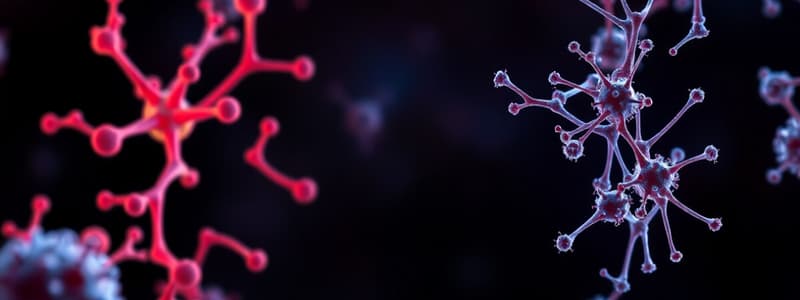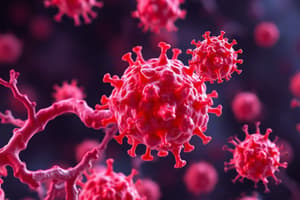Podcast
Questions and Answers
Which of the following is a component of the first layer of host defense?
Which of the following is a component of the first layer of host defense?
- Complement
- Skin (correct)
- Antibodies
- T cells
Which of the following is part of the innate immune response?
Which of the following is part of the innate immune response?
- Antibody production
- Natural killer cells (correct)
- B cell maturation
- T cell activation
In a patient with an acute bacterial infection, which complete blood count result is expected?
In a patient with an acute bacterial infection, which complete blood count result is expected?
- Decreased white blood cell count
- Increased red blood cell count
- Elevated neutrophils (correct)
- Decreased platelet count
Antihistamines counteract histamine release by which cells?
Antihistamines counteract histamine release by which cells?
Which cell type is LEAST likely to be found in aspirated joint fluid from a knee of someone with rheumatoid arthritis?
Which cell type is LEAST likely to be found in aspirated joint fluid from a knee of someone with rheumatoid arthritis?
A patient presents with a cough and itchy eyes. What is the MOST likely cause?
A patient presents with a cough and itchy eyes. What is the MOST likely cause?
Which location in the body plays the MOST important role in the activation of an adaptive immune response?
Which location in the body plays the MOST important role in the activation of an adaptive immune response?
Which of the following statements is TRUE regarding natural killer (NK) cells?
Which of the following statements is TRUE regarding natural killer (NK) cells?
Flashcards
First Layer of Host Defense
First Layer of Host Defense
Physical and chemical barriers that prevent pathogens from entering the body.
Innate Immune Response
Innate Immune Response
A rapid, non-specific immune response, present from birth, that includes processes such as inflammation, phagocytosis, and the complement system.
CBC in Bacterial Infection
CBC in Bacterial Infection
Elevated white blood cell count, particularly neutrophils, indicating the body is fighting an infection.
Antihistamines Target Cells
Antihistamines Target Cells
Signup and view all the flashcards
Activation of Adaptive Immune Response
Activation of Adaptive Immune Response
Signup and view all the flashcards
Role of Cytokines
Role of Cytokines
Signup and view all the flashcards
Inflammaging
Inflammaging
Signup and view all the flashcards
Iron Source for RBC Synthesis
Iron Source for RBC Synthesis
Signup and view all the flashcards
Study Notes
- The skin's production of sebum and sweat provides chemical defenses as the first layer of immune protection
- Neutrophils, highly phagocytic cells, are components of the innate immune response
- Leukocytosis, an increase in neutrophil count, is expected in a patient with an acute bacterial infection
- Mast cells and basophils are the primary cell types responsible for histamine release during systemic allergic reactions
- Basophils are unlikely to be present in joint fluid aspirated from a knee with rheumatoid arthritis as they are associated to allergic inflammation
- Allergic rhinitis, with symptoms like a stuffy/runny nose, sneezing, itchy eyes, postnasal drip and cough, is the likely cause of a cough and itchy eyes
- Lymph nodes facilitate communication among antigen-presenting cells, T cells, and B cells during the development of an immune response
- Natural killer cells are active in killing virus-infected and cancerous cells
- Macrophages, T cells, and B cells responding to tissue antigens result in chronic inflammation, pain, swelling, and impaired function
- Innate immunity starts with myeloid lineage blood cells and involves recognition of common pathogen patterns
- Macrophages are responsible for cytokine production and persistence in wounds, facilitating wound healing
- Filaggrin gene mutations may allow breaks in the epithelial barrier that contribute to atopic dermatitis
- Inflammaging is a shift to a pro-inflammatory state due to the homeostatic control and less balanced immune system.
- A red blood cells' small size and membrane flexibility enables movement through capillaries, important for normal red cells survival
- Iron ions released when red blood cells break down bind to plasma transferrin and are transported to the bone marrow for new red blood cell production; about 95% of iron comes from this recycling process
- Higher mean cell volume is indicative of B12 deficiency, while lower mean cell volume suggests iron-deficiency
- A major indicator of hemolytic anemias is jaundice and hyperbilirubinemia due to accelerated red blood cell breakdown, leading to elevated bilirubin levels
- Vitamin K is oxidized during liver clotting factor carboxylation, this is required for clotting factor function
- Both rheumatoid arthritis and immobility during long trips increases the risk of deep vein thrombosis (DVT)
- Spleen circulation is the source of most of the iron needed for new red blood cell synthesis
- Loss of erythropoietin production is the primary pathogenic factor causing anemia in chronic kidney disease (CKD)
- Synthesis and secretion of prostacyclin (PGI2), a vasodilator and inhibitor of platelet adhesion, is characteristic of normal endothelial cells
- Aspirin inhibits cyclooxygenase, preventing platelets from synthesizing thromboxane and reduces platelet aggregation and activation
- Dehydration is NOT part of "Virchow's triad" factors which promote clot formation
- Iron is stored intracellularly, with the greatest storage in in the liver
- Myocardial infarctions can arise from hypercoagulability and dysregulation of homeostasis
- Iron-deficiency anemia is characterized by blood cells that appear microcytic and hypochromic on a peripheral blood smear
- Laminar flow and high velocity cause shear stress in arteries
- The abdominal aorta is the most common site of atherosclerosis and abdominal aortic aneurysm formation
- Platelet adhesion to plaque and thrombus formation happens last in the progress of atherosclerosis
Studying That Suits You
Use AI to generate personalized quizzes and flashcards to suit your learning preferences.



